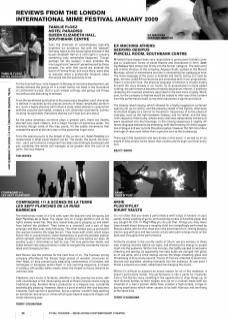The melancholy notes of a lone cello open the beautiful and intriguing Les Sept Planches de la Ruse. The player sits on a large platform and as the lights slowly reveal her, they also reveal body parts popping up and down from behind the platform. They come to a standstill and a pair of legs emerges and flips over, body following. The other bodies pop up and watch this woman traverse the large terrain. They move with small, silent steps, Butoh-like in concentration; lower themselves to push the wooden podium which spreads itself across the stage, doubling in size before our eyes. At another push it diminishes to half its size. The lone performer twists and slides herself into new positions in order to navigate the constantly manipulated and changing terrain.
And therein lies the premise for the next hour or so. The fourteen strong company effortlessly flip these large pieces of wooden structures on their head, sit atop precariously balancing combinations of triangles and rectangles or disappear within them. In one stunning sequence, a stream of endless silhouettes walks slowly down the sloped surfaces towards an unknown fate.
Stéphane Ley’s music is fantastic, whether it is the soaring live score, delicate soundscape or the intoxicating sound of three Chinese voices singing traditional song. Aurélien Bory’s production is a magical one, constantly aesthetically pleasing. However, there is a point at which the ruse becomes tiresome. Each section is wondrous, but as a whole I couldn’t help wanting an emotional resonance or climax which goes beyond exquisite images and clever balancing acts.

